1996 CHEVROLET TAHOE fuel
[x] Cancel search: fuelPage 287 of 403
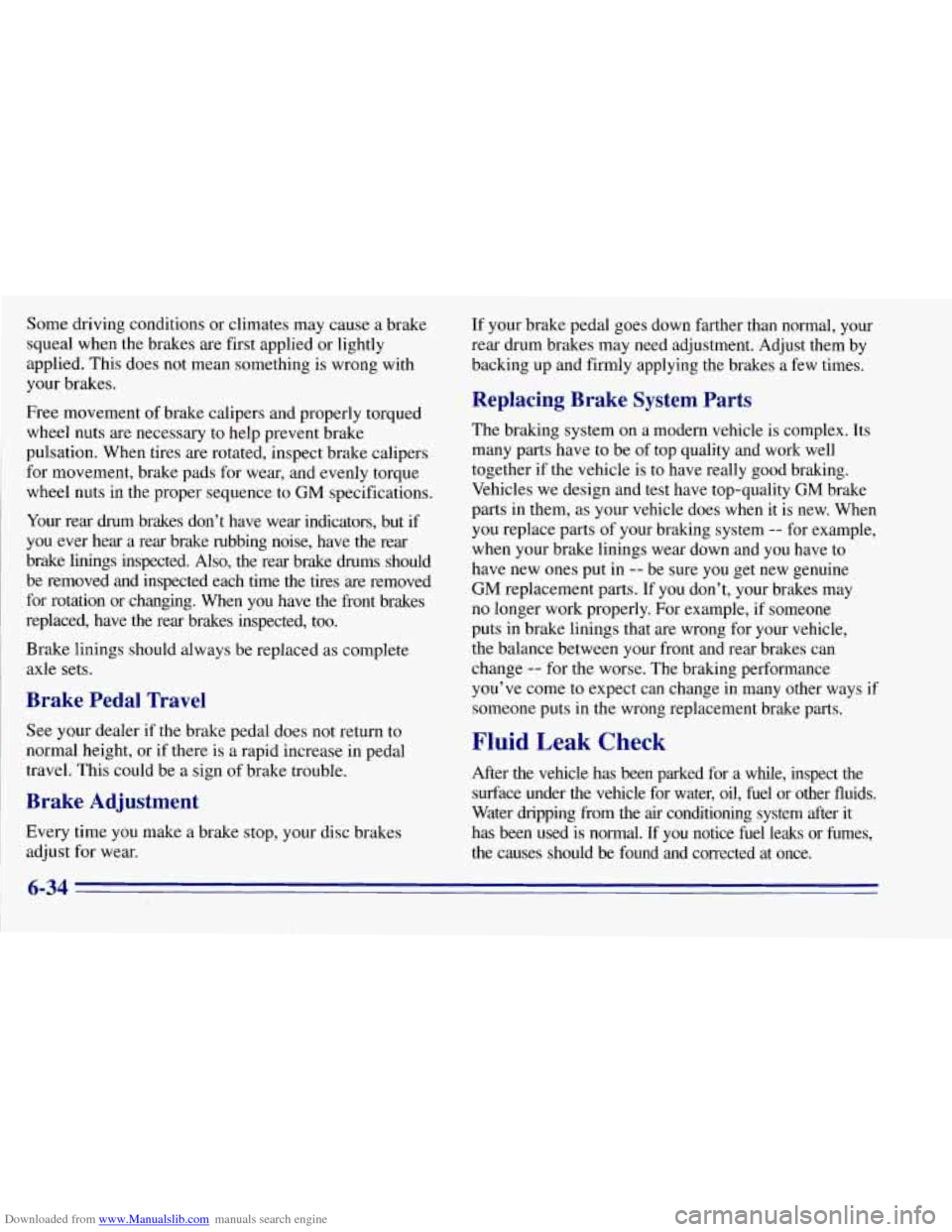
Downloaded from www.Manualslib.com manuals search engine Some driving conditions or climates may cause a brake
squeal when the brakes are first applied or lightly
applied. This does not mean something is wrong with
your brakes.
Free movement
of brake calipers and properly torqued
wheel nuts are necessary
to help prevent brake
pulsation. When tires are rotated, inspect brake calipers
for movement, brake pads for wear, and evenly torque
wheel nuts in the proper sequence to
GM specifications.
Your rear drum brakes don’t have wear indicators, but if
you ever hear a rear brake rubbing noise, have the rear
brake linings inspected. Also, the rear brake drums should
be removed and inspected each time the tires are removed
for rotation or changing. When you have the front brakes
replaced, have the rear brakes inspected, too.
Brake linings should always be replaced as complete
axle sets.
Brake Pedal Travel
See your dealer if the brake pedal does not return to
normal height, or
if there is a rapid increase in pedal
travel. This could be a sign of brake trouble.
Brake Adjustment
Every time you make a brake stop, your disc brakes
adjust for wear. If
your brake pedal goes down farther than normal, your
rear drum brakes may need adjustment. Adjust them by
backing up and firmly applying the brakes a few times.
Replacing Brake System Parts
The braking system on a modern vehicle is complex. Its
many parts have to be of top quality and work well
together if the vehicle is to have really good braking.
Vehicles we design and test have top-quality
GM brake
parts in them, as your vehicle does when it is new. When
you replace parts of your braking system
-- for example,
when your brake linings wear down and you have to
have new ones put in
-- be sure you get new genuine
GM replacement parts. If you don’t, your brakes may
no longer work properly. For example, if someone
puts in brake linings that are wrong for your vehicle,
the balance between your front and rear brakes can
change
-- for the worse. The braking performance
you’ve come to expect can change in many other ways if
someone puts in the wrong replacement brake parts.
Fluid Leak Check
After the vehicle has been parked for a while, inspect the
surface under the vehicle for water, oil, fuel or other fluids\
.
Water dripping from the air conditioning system after
it
has been used is normal. If you notice fuel leaks or fumes,
the causes should
be found and corrected at once.
6-34
Page 297 of 403

Downloaded from www.Manualslib.com manuals search engine Inflation -- Tire Pressure
The CertificationRire label, which is on the rear edge of
the driver’s door, or on the incomplete vehicle document
in the cab, shows the correct inflation pressures for your
tires when they’re cold. “Cold” means your vehicle has
been sitting for at least three hours or driven no more
than
1 mile ( 1.6 km).
You can operate some vehicles at reduced inflation
pressures only when you’ll be carrying reduced loads.
On those vehicles, the minimum cold inflation pressures
for a typical reduced load are printed on the Improved
Ride Tire Pressure label located on the driver’s door.
Weigh the vehicle to find the load on each tire and see
the label
for the minimum cold inflation pressures for
that load.
NOTICE:
Don’t let anyone tell you that underinflation or
overinflation is
all right. It’s not. If your tires
don’t have enough air (underinflation), you can
get the following:
Too much flexing
Too much heat
Tire overloading
Bad wear
Bad handling
Bad fuel economy.
If your tires have too much air (overinflation),
you can get the following:
Unusual wear
Bad handling
Rough ride
Needless damage from road hazards.
6-44
Page 311 of 403
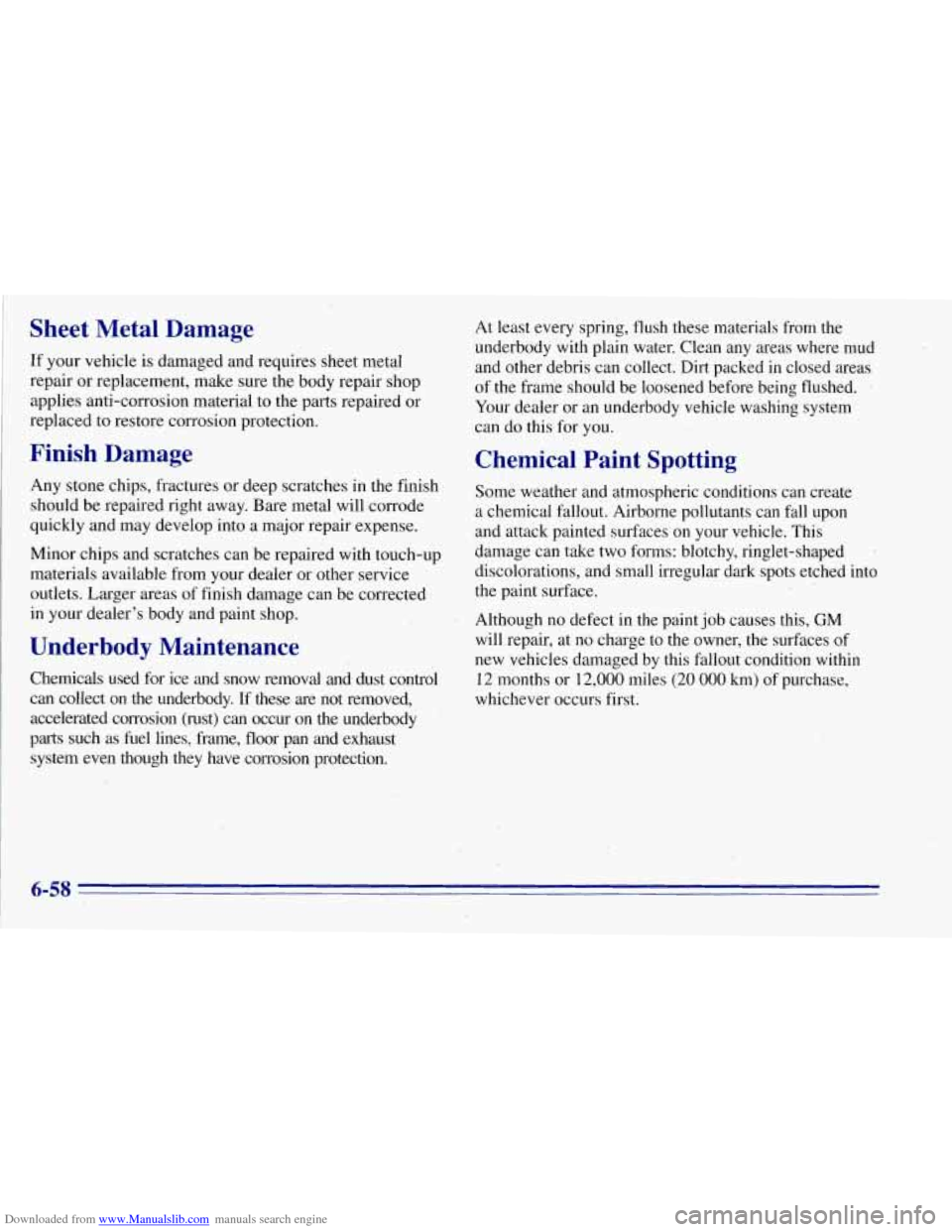
Downloaded from www.Manualslib.com manuals search engine Sheet Metal Damage
If your vehicle is damaged and requires sheet metal
repair or replacement, make sure the body repair shop
applies anti-corrosion material to the parts repaired or
replaced to restore corrosion protection.
Finish Damage
Any stone chips, fractures or deep scratches in the finish
should be repaired right away. Bare metal will corrode
quickly and may develop into a major repair expense.
Minor chips and scratches can be repaired with touch-up
materials available from your dealer or other service
outlets, Larger areas of finish damage can
be corrected
in your dealer’s body and paint shop.
Underbody Maintenance
Chemicals used for ice and snow removal and dust control
can collect on the underbody.
If these are not removed,
accelerated corrosion (rust)
can occur on the underbody
parts such as
fuel lines, frame, floor pan and exhaust
system even though they have corrosion .protection. At least every spring, flush these materials from the
underbody with plain water. Clean any areas where mud
and other debris can collect. Dirt packed in closed areas
of the frame should be loosened before being flushed.
Your dealer or an underb.ody vehicle washing system
can do this for you.
.<
Chemical Paint Spotting
Some weather and atmospheric conditions can create
a chemical fallout. Airborne pollutants can fall upon
and attack painted surfaces on your vehicle. This
damage can take two forms: blotchy, ringlet-shaped
’
discolorations, and small irregular dark spots etched into
the paint surface.
Although no defect in the paint job causes this,
GM
will repair, at no charge to the owner, the surfaces of
new vehicles damaged by this fallout condition within
12 months or 12,000 miles
(20 000 km) of purchase,
whichever occurs first.
6-58
Page 320 of 403
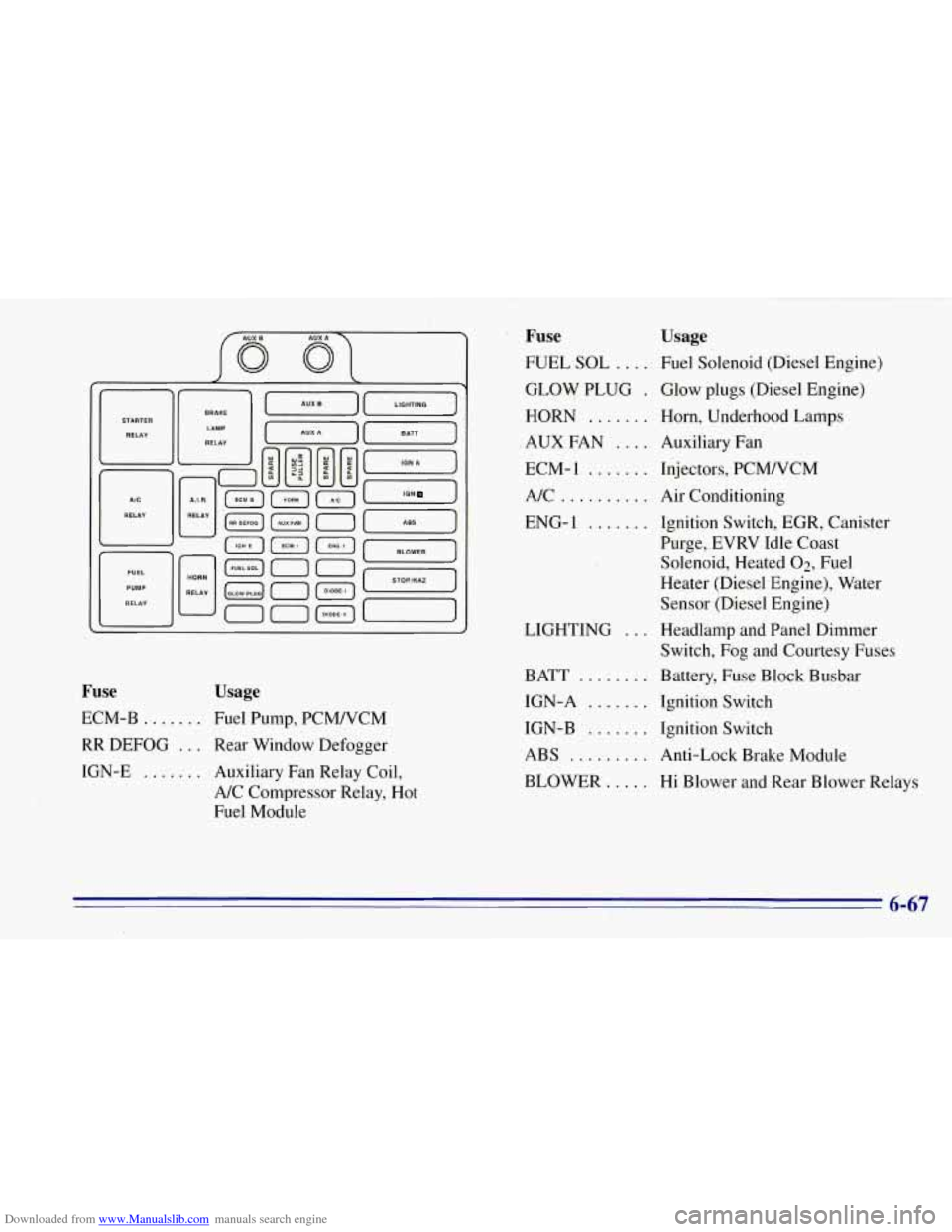
Downloaded from www.Manualslib.com manuals search engine U
RELAY
[-I RELAY
00
ION J
Fuse Usage
ECM-B ....... Fuel Pump, PCMNCM
RR DEFOG ... Rear Window Defogger
IGN-E
....... Auxiliary Fan Relay Coil,
A/C Compressor Relay, Hot
Fuel Module
Fuse
FUEL SOL ....
GLOW PLUG ,
HORN .......
AUX FAN ....
ECM- 1 .......
A/c ..........
ENG- 1 .......
LIGHTING ...
BATT ........
IGN-A .......
IGN-B .......
ABS .........
BLOWER. ....
Usage
Fuel Solenoid (Diesel Engine)
Glow plugs (Diesel Engine)
Horn, Underhood Lamps
Auxiliary Fan
Injectors, PCM/VCM
Air Conditioning Ignition Switch, EGR, Canister
Purge, EVRV Idle Coast
Solenoid, Heated
02, Fuel
Heater (Diesel Engine), Water
Sensor (Diesel Engine)
Headlamp and Panel Dimmer
Switch, Fog and Courtesy Fuses
Battery, Fuse Block Busbar
Ignition Switch
Ignition Switch
Anti-Lock Brake Module
Hi Blower and Rear Blower Relays
6-67
Page 323 of 403
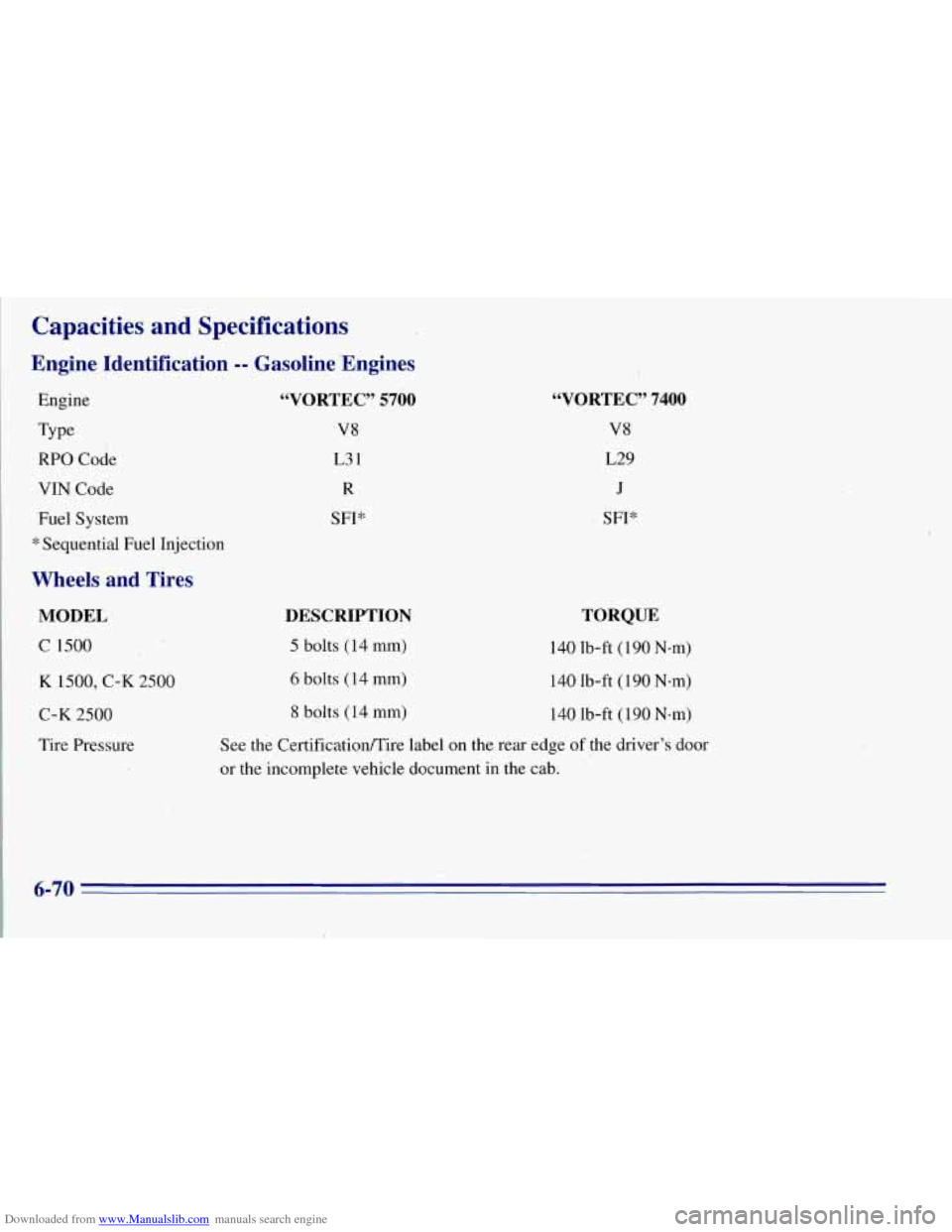
Downloaded from www.Manualslib.com manuals search engine Capacities and Specifications
Engine Identification -- Gasoline ‘Engines
Engine
Type
RPO Code
VIN Code
Fuel System
* Sequential Fuel Injection
Wheels and Tires
MODEL
C 1500
K 1500, C-K 2500
C-K 2500
Tire Pressure
“VORTEC” 5700
V8
L3 1
R
SFI*
“VORTEC” 7400
V8
L29
J
SFI*
DESCRIPTION
TORQUE
5 bolts (14 mm) 140 lb-ft (190 N-m)’
6 bolts (14 mm) 140 lb-ft ( 190 N-m)
8 bolts (14 mm)
140 lb-ft (190 Nem)
See the Certificatioflire label on the rear edge of the driver’s door
or the incomplete vehicle document in the cab.
6-70
Page 324 of 403

Downloaded from www.Manualslib.com manuals search engine Normal Maintenance Replacement Parts -- Gasoline Engines
Replacement part numbers listed In this section are based on the latest information available at the time of printing,
and are subject to change.
If a part listed in this manual is not the same as the part used in your .vehicle when it was
built, or
if you have any questions, please contact your GM truck dealer.
Engine
VORTEC” 5700
VIN R Oil Filter PF1218T
Air Cleaner Filter
A 1300C
Spark Plugs * 4 1-932
Spark Plug Gap
0.060 in. (1.52 mm)
Fuel Filter GF626
Wiper Blades. (Front) 22154886
Wiper Blade Type (Front) Trico
Wiper Blade Length (Front) 18 inches
(45.0 cm)
Wiper Blade (Rear) 22154396
Wiper Blade Type (Rear) Trico
Wiper Blade Length (Rear) 14 inches (35.5 cm)
“four-Wheel-Drive Vehicles
-- use a PF52 oil filter.
46VORTEC” 7400
J
PF1218
A1 3OOC
4 1-932
0.060 in. (1.52 mm)
GF626
22154886 Trico
18 inches
(45.0 cm)
22154396
Trico
14 inches (35.5 cm)
Page 326 of 403
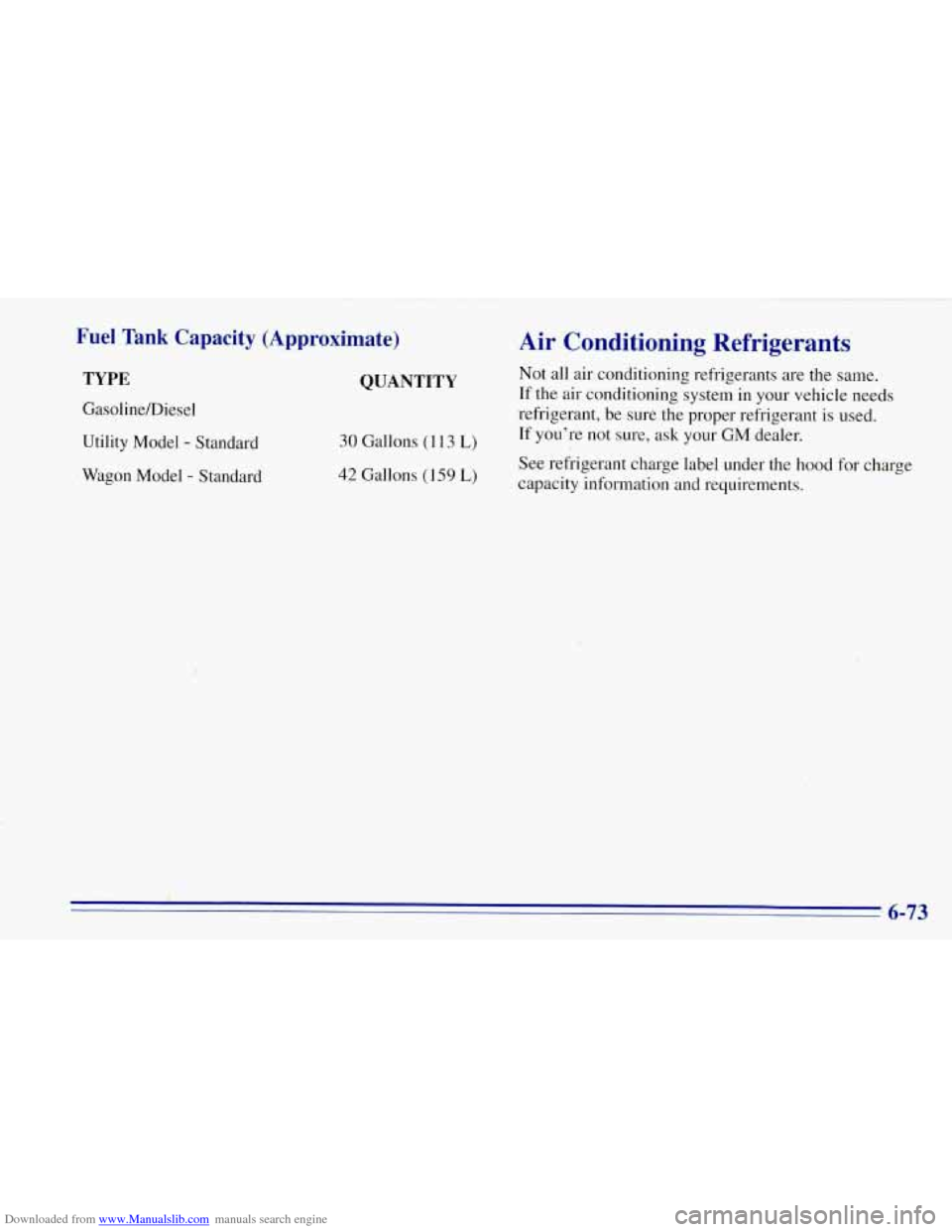
Downloaded from www.Manualslib.com manuals search engine Fuel Tank Capacity (Approximate)
TYPE
Gasoline/Diesel
Utility Model
- Standard
Wagon Model
- Standard
QUANTITY
30 Gallons (1 13 L)
42 Gallons (159 L)
Air Conditioning Refrigerants
Not all air conditioning refrigerants are the same.
If the air conditioning system in your vehicle needs
refrigerant, be sure the proper refrigerant
is used.
If you're not sure, ask your GM dealer.
See refrigerant charge label under the hood for charge
capacity information and requirements.
Page 329 of 403

Downloaded from www.Manualslib.com manuals search engine How This Section is Organized
The remainder of this section is divided into five parts:
“Part A: Scheduled Maintenance Services” shows
what to h-ave done and how often. Some
of these
services can be complex,
so unless you are technically
qualified and have the necessary equipment,
you should
let your dealer’s service department or another qualified
service center
do these jobs.
A CAUTION:
I
If you are skilled enough to do some work on your
vehicle, you will probably want to get
the service
information
GM publishes. See “Service and Owner
Publications”
in the Index.
“Part B: Owner Checks and Services” tells you
what should be checked whenever you stop for fuel. It
also explains what you can easily do to help keep your
vehicle in good condition.
“Part C: Periodic Maintenance Inspections”
explains important inspections that your GM dealer’s
service department or another qualified service center
should perform.
Performing maintenance work on a vehicle can “Part D: Recommended Fluids and Lubricants”
be dangerous. In trying to do some jobs, you can
be seriously injured.
Do your own maintenance
work only
if you have the required know-how
’ and the proper tools and equipment for the job.
If.you have any doubt, have a qualified “Part
E: Maintenance Record” provides a place
technician do the work.
lists some products GM recommends to help keep your
vehicle properly maintained. These products, or their
equivalents, should be used whether you do the.work
yourself or have
it done.
for
you to record the maintenance performed on your
vehicle. Whenever any maintenance is performed, be
I I sure to write it down in this part. This will help you
determine when your next maintenance should be done.
In addition, it is a good idea to keep your maintenance
receipts. They may be needed to qualify your vehicle for
warranty repairs.